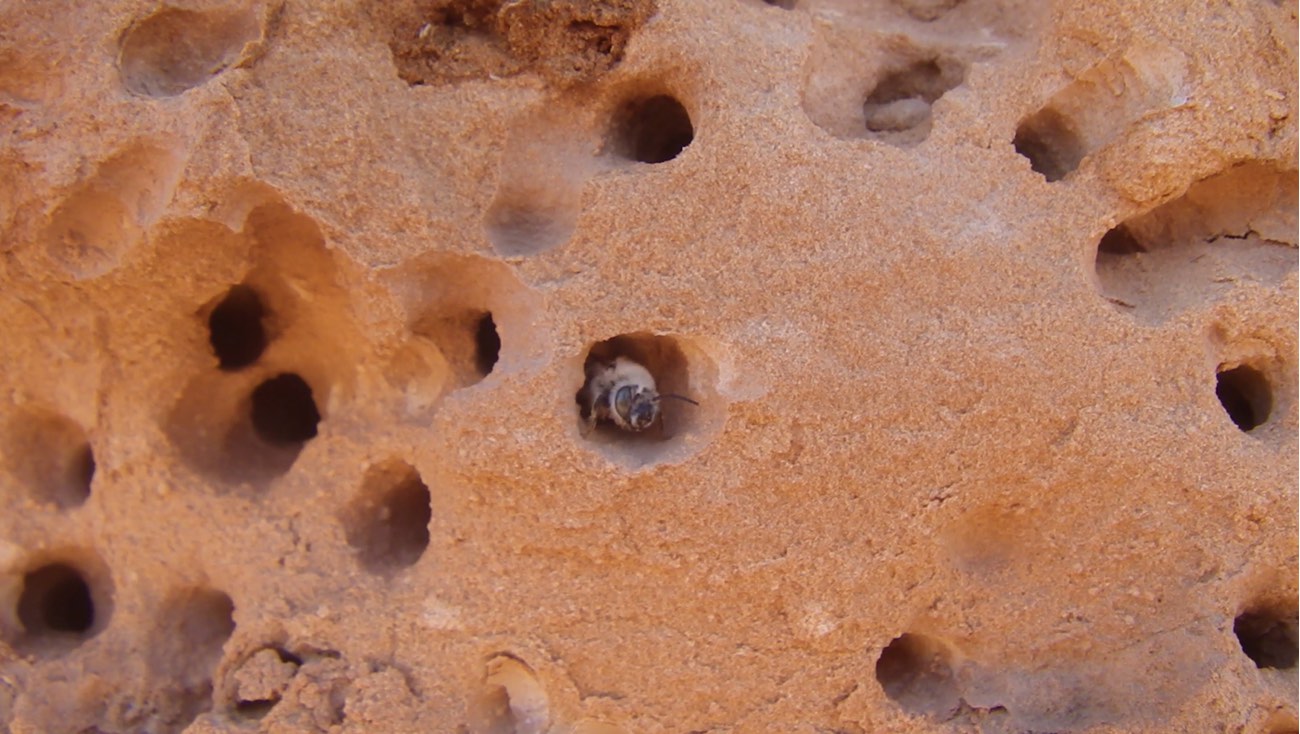'Unusual' Bee Species Drills Apartment-Style Nests Out of Rock

A newly discovered species of bee does things the hard way, gnawing its nests out of solid rock even when softer dirt is available.
This hard work appears to pay off, however, by providing the bees greater protection from the vagaries of life in the desert Southwest. The species, dubbed Anthophora pueblo, has been found in Utah, in southwest Colorado and in Death Valley in California, where it pocks vertical sandstone rock faces with tiny holes. Though the bees seem to be solitary nesters, they build these rocky alcoves next to one another, like insect apartment-dwellers.
"The bee is very unusual," study researcher Michael Orr, a doctoral student in biology at Utah State University, told Live Science. [See Images of the Sandstone Bee Nests]
Hidden discovery
The first hint of Anthophora peublo's existence dates back to the early 1980s, when entomologist Frank Parker — an author on the current study and the former head of the U.S. Department of Agriculture Bee Lab in Utah — discovered bees nesting in holes dug into sandstone in Utah's San Rafael Desert. Parker chipped out a couple of blocks of sandstone and reared the bees until they emerged from the rock; the nests and bee specimens then sat in a museum collection, unstudied.
Flash forward to the present day, when Orr began doing fieldwork studying other members of the Anthophora genus. He'd seen bees using the sandstone nests, and when Parker told him about the original discoveries in the 1980s, he knew he had to investigate more fully.
He did some detective work to rediscover Parker's original field sites, where the gap is still visible from the chunk of rock he chiseled out 36 years ago, Orr said. Something else remains the same, too.
"One of the greatest moments for me of this project was going back and revisiting that site from almost 40 years ago, and just walking up and the bees are still there," Orr said. "They're still using this same spot."
Sign up for the Live Science daily newsletter now
Get the world’s most fascinating discoveries delivered straight to your inbox.
Orr and his colleagues discovered the sandstone-dwelling bees at seven sites total, the researchers reported on Sept. 12 in the journal Current Biology. They're mostly found in natural rock formations, but some nest in ancient Pueblo dwellings made by human hands — lending them their species name.
The bees, which are covered in the familiar black-and-yellow stripes, nest in sandstone at all but two sites, Orr said, where they burrow into silt. At these silt sites, the sandstone is about 2.5 times harder than the sandstones that the bees burrow into.
"They prefer it up until it's at a certain hardness threshold and then it doesn't make sense for them anymore," he said.
Costs of excavating
There's a cost to burrowing in stone. Older female bees commonly show wear and tear on their mandibles, Orr and his colleagues reported, and it takes more energy and time to dig through sandstone than dirt. However, there's evidence that building nests to last confers benefits to the bees' offspring, which may reuse their parents' tunnels. The bees are also able to hole up in their dwellings and delay emergence for up to four years when times are lean and not many desert flowers are blooming; sandstone probably protects the bees from erosion or flash floods better than dirt during these long quiescent periods, the researchers wrote.
While long-lasting nests used through multiple generations can attract parasites, the sandstone also seems to stymy freeloaders, the researchers found. In the sandstone blocks found in 1980, the nesting sites had been colonized by parasitic beetles called Tricrania stansburii. The larva of these beetles hitch rides on bees back to the bee nests. However, only six out of 69 larvae had successfully emerged from their nesting cells, Orr said. The rest died, unable to get out of the tough stone. The hardness of the rock seems to help keep the parasite population in check. [The 10 Most Diabolical and Disgusting Parasites]
The sandstone should also deter microbial parasites. "Sandstone has relatively little organic matter in it naturally because of the way it's formed, and because of that most of the microbes that are using it are making their own food through things like photosynthesis," which requires sunlight, he said. "Anything making its own food through photosynthesis will be much less likely to invade a bee's nest and eat the bee's food."
The bee nests also provide a sort of secondary shelter for insects and arachnids that can't chew through rock on their own, Orr said. At least 20 species use the burrows, about half of which are parasites. Other "renters" of the rock apartments include spiders, other bee species and wasps, he said.
In the future, Orr hopes to track the bees as they come and go to find out if they're entirely solitary or if they cooperate to share nests. He's also working to get the local Native American community involved in the study and to draw more non-scientists into noticing these odd bees.
"I'm hoping to build kind of this sort of citizen science network where people can report these nest sites to me," he said. Acting on tips and doing his own explorations, he's found more than 50 new nesting sites since the paper was submitted to the journal, he said.
Original article on Live Science.

Stephanie Pappas is a contributing writer for Live Science, covering topics ranging from geoscience to archaeology to the human brain and behavior. She was previously a senior writer for Live Science but is now a freelancer based in Denver, Colorado, and regularly contributes to Scientific American and The Monitor, the monthly magazine of the American Psychological Association. Stephanie received a bachelor's degree in psychology from the University of South Carolina and a graduate certificate in science communication from the University of California, Santa Cruz.









